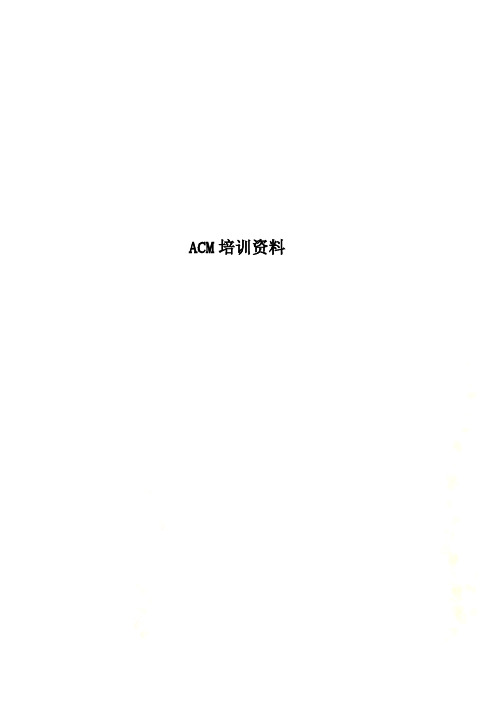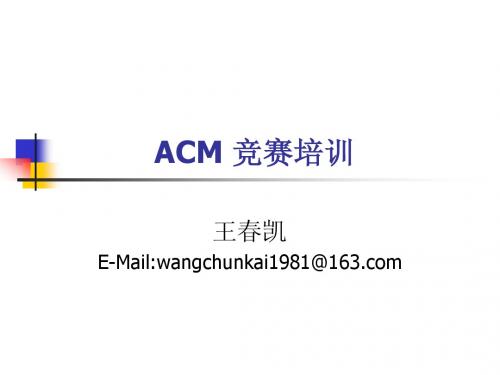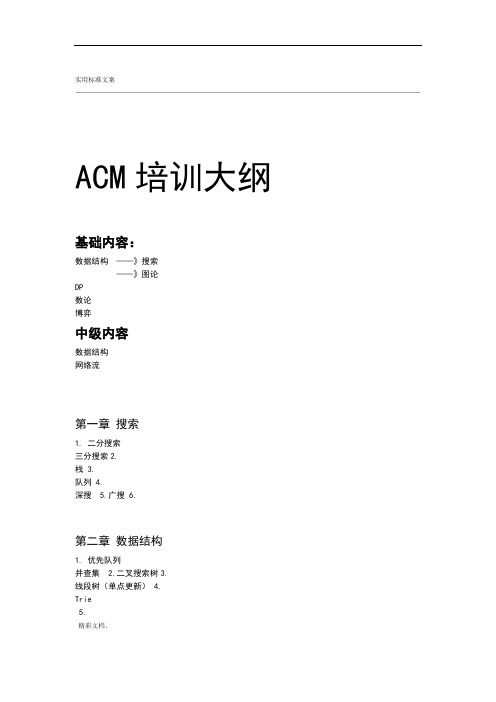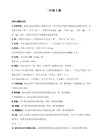清华大学ACM集训队培训资料内部使用
(培训体系)清华大学AM集训队企业培训资料

(培训体系)清华大学AM 集训队企业培训资料程序说明第一行“#include<iostream>”,是一句预处理命令,相当于把“iostream”这个文件的所有内容复制到当前位置,替换该行。
因为在输出操作中需要做很多事,C++编译器就提供了很多已经写好的函数(成为C++标准库),我们做的只是拿来用就可以了。
第二行的“usingnamespacestd;”是使用标准命名空间,因为我们在程序中用到了在标准命名空间里的函数和对象。
目前可以不了解其具体如何实现,在以后的程序设计中可以再对其进行了解。
在明函数中“cout<<”HelloWorld!”<<endl;”是在屏幕上打印“HelloWorld!”,“endl”表明打印完这句话之后需要换行。
如果我们替换引号内的内容,程序的输出就会相应改变。
另外一个C++程序例子//--definingyourownfunction#include<iostream>voidsimon(int);//functionprototypeforsimon()intmain(){usingnamespacestd;simon(3);//callthesimon()functioncout<<"Pickaninteger:";intcount;cin>>count;simon(count);//callitagaincout<<"Done!"<<endl;return0;}voidsimon(intn)//definethesimon()function{usingnamespacestd;cout<<"Simonsaystouchyourtoes"<<n<<"times."<<endl;}//voidfunctionsdon'tneedreturnstatements下面试运行情况:Simonsaystouchyourtoes3times.Pickaninteger:512Simonsaystouchyourtoes512times.Done!程序中包含了cin语句来从键盘上获取数据。
清华大学ACM题解

if (k==n){ //Output permutation.
for (int i-1; i<n; i++) cout<<a[i]<<" ";
}
else //a[k:n] has more than one permutation.
// Generate these recursively.
{
int a[3] = {1, 2, 3};
Perm(a, 0, 3);
return 0;
}
该程序的运行结果为
1 2 3
1 3 2
2 1 3
2 3 1
3 2 1
3 1 2
那么,该函数就完成了对一个数组进行全排列的操作
下面,分析该程序,我用圆圈代表每次函数的调用
对于数据的输入和输出有几道练习题
/showproblem.php?pid=1089
至
/showproblem.php?pid=1096
二、算法基础
1. 什么是算法
算法是完成特定任务的有限指令集。所有的算法必须满足下面的标准:
编辑源文件
能够提共管理程序开发的所有步骤,包括编辑的程序成为集成开发环境(integrated development evironments, IDE)。在windows系统下,使用较为广泛的有Microsoft Visual C++、Dev-Cpp等,在UNIX系统下,有Vim、emacs、eclipes等。这些程序都能提供一个较好的开发平台,使我们能够方便的开发一个程序,接下我们所要了解的都是标准C++,所有源代码都在Dev-cpp下编写,能够编译通过。
ACM培训材料PPT课件

}
2020/10/13
7
注意上面程序的M的好处
上面M定义为10000,这样不仅提高了效率而 且也节省了空间
如果要你把N阶乘转成2或3进制你会吗? 如:把18!转换成2进制. 如果你不会,那么你还没对那个程序M深刻
理解.
2020/10/13
8
N!末尾有多少个0
很简单,只要N!有多少个5这个因子,就有多少 个0.
进位e=0 (e=(a[1]+b[1]+e)/10) c[2]=(a[2]+b[2])%10+e=0, 百位进位e=1,依次下去,
最后把数组输出就是结果(要倒过来输出)
2020/10/13
4
对上面例子的实现
#include<stdio.h>
#include<string.h>
#define N
{
p=a[i]+b[i]+e;
c[i]=p%10;
e=p/10;
}
lc=lb;
while(e>0)
{
lc++;
c[lc]=e%10;
e/=10;
}
for(i=lc;i>=0;i--)
{
printf("%d",c[i]);
}
printf("\n");
return 0;
}
2020/10/13
5
用高精度算N阶乘
汇报人:XXXX 日期:20XX年XX月XX日
11
详细见课堂分析.
2020/10/13
9
fjnu:1743 fjnu:1185 fjnu:1307 fjnu:1191 fjnu:1158
ACM培训资料

ACM培训资料目录第一篇入门篇 (3)第1章新手入门 (5)1ACM国际大学生程序设计竞赛简介 (5)2ACM竞赛需要的知识 (8)3团队配合 (14)4练习、练习、再练习 (15)5对新手的一些建议 (16)第2章C++语言介绍 (22)1C++简介 (22)2变量 (23)3C++数据类型 (25)4C++操作符 (30)5数组 (35)6字符数组 (38)7字串操作函数 (41)8过程控制 (45)9C++中的函数 (54)10函数规则 (59)第3章STL简介 (61)1泛型程序设计 (61)2STL 的组成 (67)第二篇算法篇 (102)第1章基本算法 (103)1算法初步 (103)2分治算法 (115)3搜索算法 (124)4贪婪算法 (135)第2章进阶算法 (165)1数论基础 (165)2图论算法 (180)3计算几何基础 (222)第三篇实践篇 (246)第1章《多边形》 (247)第2章《灌溉问题》 (255)第3章《L GAME》 (263)第4章《NUMBER》解题报告 (271)第5章《J OBS》解题报告 (275)第6章《包裹运送》 (283)第7章《桶的摆放》 (290)第一篇入门篇练就坚实的基础,总有一天……我们可以草木皆兵!第1章新手入门1ACM国际大学生程序设计竞赛简介1.1背景与历史1970年在美国TexasA&M大学举办了首次区域竞赛,从而拉开了国际大学生程序设计竞赛的序幕。
1977年,该项竞赛被分为两个级别,即区域赛和总决赛,这便是现代ACM竞赛的开始。
在亚洲、美国、欧洲、太平洋地区均设有区域赛点。
1995至1996年,来自世界各地的一千多支高校的代表队参加了ACM区域竞赛。
ACM 大学生程序设计竞赛由美国计算机协会(ACM)举办,旨在向全世界的大学生提供一个展示和锻炼其解决问题和运用计算机能力的机会,现已成为全世界范围内历史最悠久、规模最大的大学生程序设计竞赛。
ACM培训计划

ACM培训计划书制作人:xxx2008/10/21一、什么是ACMACM/ICPC ( ACM International Collegiate Programming Contest)国际大学生程序设计竞,ACM/ICPC 是由国际计算机界历史悠久、颇具权威性的组织ACM (Association for Computing Machinery ,美国计算机协会) 主办的,世界上公认的规模最大、水平最高的国际大学生程序设计竞赛,其目的旨在使大学生运用计算机来充分展示自己分析问题和解决问题的能力。
该项竞赛从1970 年举办至今已历31 届,一直受到国际各知名大学的重视,并受到全世界各著名计算机公司的高度关注,在过去十几年中,APPLE 、AT&T 、MICROSOFT 和IBM 等世界著名信息企业分别担任了竞赛的赞助商。
可以说,ACM 国际大学生程序设计竞赛已成为世界各国大学生最具影响力的国际级计算机类的赛事,是广大爱好计算机编程的大学生展示才华的舞台,是著名大学计算机教育成果的直接体现,是信息企业与世界顶尖计算机人才对话的最好机会。
该项竞赛分区域预赛和国际决赛两个阶段进行,各预赛区第一名自动获得参加世界决赛的资格,世界决赛安排在每年的 3 ~ 4 月举行,而区域预赛安排在上一年的9 ~12 月在各大洲举行。
ACM/ICPC 的区域预赛是规模很大、范围很广的赛事。
仅在2003 年参加区域预赛的队伍就有来自75 个国家(地区),1411 所大学的3150 支代表队,他们分别在127 个赛场中进行比赛,以争夺全球总决赛的73 个名额,其激烈程度可想而知。
2004 年第29 届ACM/ICPC 亚洲赛区预赛共设了北京、上海、台北、高雄、汉城、德黑兰、爱媛(日本)、达卡(孟加拉国)、马尼拉、坎普尔(印度)等10 个赛站,来自亚洲各国知名高校的各个代表队进行了激烈的角逐。
中国内地从1996 年开始参加ACM/ICPC 亚洲区预赛,至今已历九届。
ACM 竞赛培训

河南赛区赛题3
【 样例 】
河南赛区赛题4-枚举
在灾区,多数人已经受伤,缺水,少食物,精神处在崩溃的边缘。很多人的生存条件仅能维持几天。灾民 需要帐篷、衣物、食品和医疗器材、药品等物资。14日上午,中央军委委员、空军司令员许其亮组织召开 空军首长办公会,将空军下一步救灾重点确定为抢救伤员、空投、空运。空军各部队都派出多架运输机, 准备向灾区空运急需物品。 现在已知四种打包过的急需物品重量分别为C1, C2, C3,C4 ,数量分别为M1,M2,M3,M4包。一架运输 机的载重量为W, 现在各部队关心将一架运输机装满共有多少种运载方案,以便调度进行空运。 比如C={ 100, 200, 500, 1000},M={ 3, 2, 3, 1 }, W=1000, 一共有4种运载方案: 1000=100+100+100+200+500 1000=100+200+200+500 1000=500+500 1000=1000 【标准输入】 C1 C2 C3 C4 N 其中 N为空运的部队数 Mi1 Mi2 Mi3 Mi4 Wi 表示各运载部队需空运的4种物品数量Mi 和各自运输机的载重量Wi i=1,2,….. , N
河南赛区赛题2
【样 例】
河南赛区赛题3-排序查找算法
【试题三】 密码破译 某组织欲破获一个外星人的密码,密码由一定长度的字串组成。此组织拥有一些破译此密码 的长度不同的钥匙,若两个钥匙的长度之和恰好为此密码的长度,则此密码被成功破译。现 在就请你编程找出能破译此密码的两个钥匙。 【标准输入】 第一行: N N为钥匙的个数(1<=N<=1000) 第二行: L L为密码的长度 以下有N行: Ai 每一行是一把钥匙的长度 i=1,2,……,N 【标准输出】 若无法找到破译此密码的钥匙,则输出0 若找到两把破译的钥匙,则输出文件有两行,分别为两把钥匙的编号,按从小到大输出。若 有多种破译方案,则只输出包含起始编号最小的一组即可。 [【约束条件】 (1)1<= N,L,Ai <=1000(i=1, 2, ….., N ) (2)时间限制: 1000MS
清华大学ACM集训队培训资料(内部使用)

return 0;
}
int stonetolb(int sts)
{
return 14 * sts;
}
下面是运行情况:
Enter the weight in sone:14
14 stone = 196 pounds.
程序通过cin语句给stone提供一个值,然后在main函数中,把这个值传递给stonetolb()函数,这个植被赋给sts之后,stonetolb()用return将14*sts返回给main()。
type functionname (argumentlist)
{
statements
}
注意,定义simon()的代码在main()函数的后面,C++中不允许将函数定义在另一个函数内。每个函数的定义都是独立的,所有的函数的创建都是平等的。
simon()函数的函数头定义如下:
void simon(int n)
清华大学ACM集训队培训资料(内部使用)
一、C++基础
基本知识
所有的C++程序都是有函数组成的,函数又叫做子程序,且每个C++程序必须包含一个main函数,编译器(能够把源代码转换成目标代码的程序)把翻译后的目标代码和一些启动代码组合起来,生成可执行文件,main函数就是可执行文件的入口,所以,每个C++程序有且只有一个main函数。
如果我们修改程序1.1中的main()函数的名称,将其改为Main(),那么,IDE就会给出错误信息,比如“[Linker error] undefined reference to `WinMain@16'”,因为编译器没有找到main函数。
ACM培训大纲

实用标准文案ACM培训大纲基础内容:数据结构——》搜索——》图论DP数论博弈中级内容数据结构网络流第一章搜索1.二分搜索三分搜索2.栈3.队列4.深搜5,广搜6.第二章数据结构1.优先队列并查集2.二叉搜索树3.线段树(单点更新)4.5.精彩文档.实用标准文案第三章图论1.图的表示1.1二维数组1.2邻接表1.3前向星2.图的遍历2.1双连通分量2. 2拓扑排序3.最短路3.1迪杰斯特拉3. 2弗洛伊德4. 3 SPFA5.匹配匈牙利算法6.生成树7.网络流简介第四章动态规划1.状态转移方程2.引入3. 1 0-1背包4.2硬币问题5. 3矩阵链乘6.区间DP7.按位DP8.树形DP9.状压DP第五章数论1.欧几里得扩展欧几里得2.因数分解3. 费马小定理4.欧拉定理5.6.1筛法6. 2素数判定6. 2,1 0(Jn)方法精彩文档.实用标准文案6. 2. 2 Mi I ler-rabin 测试第六章博弈1.Nim 和2.SG函数第七章中级数据结构1.树状数组RMO 2.KMP3.AC自动机4.线段树(区间更新)5.第八章图论进阶1.网络流问题精彩文档.实用标准文案综述在很多人眼里,东北大学秦皇岛分校不算是985高校。
所以我们要用自己的能力证明我们有985 的实力。
ACM是计算机界认可度最高的一个比赛,可以说只要区域赛有过奖牌,国内任何IT公司没有理由不要。
同时,在高校之中,对一个大学计算机专业的评价,大部分人也会首先看ACM 的水平。
将ACM打出学校,在国内打出一定成绩,对扩大我校影响力很有帮助。
考虑到本校暂时没有进行专题训练的出题能力,专题训练的题目主要从UESTC 2014年集训队专题训练中获取,再加上从别的0J上找一些题目。
训练的平台设置在华中科技大学的vertual judge上面。
本人将在毕业之前承担培训任务。
在2015学年开始之前,培训计划为每两周一次,中间空闲的时间由大二或者大一熟悉C++的同学给不熟悉C++的同学进行基础的讲解。
ACM培训材料2

结束递归调用
• 要对这个函数加入结束递归调用的逻辑判断是非 常容易的。假设我们要求参数变到10(不含1 0)时,就结束,那么代码如:
void F(int a) { if( a < 10) F(a+1); } 就能成功的在未来的某个时刻结束。
递归的范例
• 试编写一个递归函数,在第一行打印输出1个1,在第二行打印输出2个 2, ……在第n行打印输出n个n。例如,当n=5时,调用该函数的输出结果为: 1 2 2 3 3 3 4 4 4 4 5 5 5 5 5 该问题的算法为:print ( int n ) { int i; if (n!=0) { print(n-1); for(i=1;i<=n;i++) printf("%d",n); printf("\n");} }
习题
• fjnu:1437 • fjnu:1994 • 只用getchar(), putchar(),不用数组,不 用循环完成一行字符串的倒过来输出 • 用递归输出单链表
本章内容
• 高精度数相乘 • 关于引用和形参 • 关于数据结构中,指针错误操作导致内存 出错的调试办法 • typedef的用法和作用 • 递归程序介绍 制作:陈江勇 2008-7-22
高精度数相乘(例子)
• • • • • • • • • • • • • • • • • #include<stdio.h> #include<string.h> #define M 10 int a[128],b[128],c[202]; int main() { int i,j,la,lb,lc; char temp[128]; while(scanf("%s",temp)!=EOF) { la=strlen(temp)-1; for(i=la,j=0;j<=la;i--,j++) sscanf(temp+j,"%1d",&a[i]); scanf("%s",temp); lb=strlen(temp)-1; for(i=lb,j=0;j<=lb;i--,j++) sscanf(temp+j,"%1d",&b[i]);
ACM培训大纲

实用标准文案ACM培训大纲基础内容:数据结构——》搜索——》图论DP数论博弈中级内容数据结构网络流第一章搜索1.二分搜索三分搜索2.栈 3.队列 4.深搜 5.广搜 6.第二章数据结构1.优先队列并查集 2.二叉搜索树3.线段树(单点更新) 4.Trie5.精彩文档.实用标准文案第三章图论1.图的表示1.1二维数组1.2邻接表1.3前向星2.图的遍历2.1双连通分量2.2拓扑排序3.最短路3.1迪杰斯特拉3.2弗洛伊德3.3SPFA4.匹配匈牙利算法5.生成树6.网络流简介第四章动态规划1.状态转移方程2.引入2.10-1背包2.2硬币问题2.3矩阵链乘3.区间DP4.按位DP5.树形DP6.状压DP第五章数论1.欧几里得扩展欧几里得 2.因数分解3.费马小定理 4.欧拉定理 5.素数6.6.1筛法6.2素数判定6.2.1O(√n)方法精彩文档.实用标准文案6.2.2Miller-rabin测试第六章博弈1.Nim和2.SG函数第七章中级数据结构1.树状数组RMQ 2.KMP3.AC自动机4.线段树(区间更新)5.第八章图论进阶1.网络流问题精彩文档.实用标准文案综述在很多人眼里,东北大学秦皇岛分校不算是985高校。
所以我们要用自己的能力证明我们有985的实力。
ACM是计算机界认可度最高的一个比赛,可以说只要区域赛有过奖牌,国内任何IT公司没有理由不要。
同时,在高校之中,对一个大学计算机专业的评价,大部分人也会首先看ACM 的水平。
将ACM打出学校,在国内打出一定成绩,对扩大我校影响力很有帮助。
考虑到本校暂时没有进行专题训练的出题能力,专题训练的题目主要从UESTC 2014年集训队专题训练中获取,再加上从别的OJ上找一些题目。
训练的平台设置在华中科技大学的vertual judge上面。
本人将在毕业之前承担培训任务。
在2015学年开始之前,培训计划为每两周一次,中间空闲的时间由大二或者大一熟悉C++的同学给不熟悉C++的同学进行基础的讲解。
ACM培训精品PPT课件

DP (Dynamic Programming) 动态编程,动 态规划
DFS (Depth First Search) 深度优先搜索
BFS (Breadth First Search) 宽度/广度优先搜 索
输入输出
%d %lld %lf自动扫描前导空格 比如:读入5个整数到A[5]
输入文件中,数的排布是这个样子
35 26 78
99
206
不管它,直接5次%d
for ( int i = 0; i < 5; i++ ) scanf(“%d”, A + i);
%lld用于输入和输出长整数(long long,64位) %lf用于输入输出double
cout<<"j="; printf("%d\n", j); } return 0; }
0
1
j=0 j=1 j=2 j=3
2 3 4 j=j=j=j=j=
j=4
输入输出
scanf
输入格式
%d %lld %c %s %lf
对每种格式搞清楚一个重要问题
是否自动跳过前导空白?
什么是空白:空格,TAB,回车
输入输出
%s 读一个字符串,自动扫描前导空白,读到 空白结束
如: abcd efgh,将读出”abcd”
%c读一个字符,但是不扫描前导空白
如何读一个非空白字符呢?
比如,读取某人的信息,其性别用M/F表示
TopBoy M ComputerScience
Kitty
ACM暑期培训资料(ppt28张)

大整数除法
1、链接地址
/problem?id=2737
2、问题描述
– 求两个大的正整数相除的商
输入数据
第1 行是测试数据的组数n,每组测试数据占2 行,第1 行是被除数,第2 行是除数。每组测试数据之间有一个空 行,每行数据不超过100 个字符
输出要求
n 行,每组测试数据有一行输出是相应的整数商
规律:一个数的第i 位和另一个数的第j 位相乘所得的数,一 定是要累加到结果的第i+j 位上。这里i, j 都是从右往左,从 0 开始数。
POJ2389 参考程序
#include<iostream> #include<string> using namespace std; const int MAXLEN=200+10; int a[MAXLEN],b[MAXLEN]; int c[2*MAXLEN]; string st1,st2; int i,j,k; //字符串s转换为整型数组t void tran(string s,int *t) { int m,l; l=s.length(); for(m=0;m<l;m++) t[m]=s[l-1-m]-'0'; }
//下面判断p1 是否比p2 大,如果不是,返回-1 if( nLen1 == nLen2 ) { for( i = nLen1-1; i >= 0; i -- ) { if( p1[i] > p2[i] ) break; //p1>p2 else if( p1[i] < p2[i] ) return -1; //p1<p2 } } for( i = 0; i < nLen1; i ++ ) { //要求调用本函数确保当i>=nLen2 时,p2[i] = 0 p1[i] -= p2[i]; if( p1[i] < 0 ) { p1[i]+=10; p1[i+1] --; } } for( i = nLen1 -1 ; i >= 0 ; i-- ) if( p1[i] )//找到最高位第一个不为0 return i + 1; return 0;//全部为0,说明两者相等 }
ACM暑期培训课程图论.ppt

E问题
OUTPUT FORMAT
输出应当有F+1行,每行一个整数,依次表示路径经 过的顶点号。注意数据可能有多组解,但是只有上面题目 要求的那一组解是认为正确的。
SAMPLE OUTPUT(fence.out) 1 2 3 4 2 5 4 6 5 7
E问题
很显然,这是一个欧拉路径问题,我们要做的就是读入栅栏的 构图后,找到图中的一条欧拉路径。
图的连通性
4. 有向图的强连通分支
在下面的几页中,我们可以看到求图的 强连通分支的实例。
首先,图(a)为有向图G,其中的阴影部 分是G的强连通分支,在对图G进行DFS 的过程中,我们对每个顶点都标出了其 开始搜索时刻preOrder与完成时刻 postOrder,黑色边为DFS搜索树树枝;
可以看到,图G共有 4个强连通分支:
{a,b,e}
{c,d}
{f,g}
{h}
图的连通性
4. 有向图的强连通分量
(b)图中G的转置图G*。图中说明了求 强连通分支算法第3部计算出的深度优 先树,其中黑色边是树枝。每个强连通
子图对应于一棵深度优先树。图中黑色 顶点b,c,g和h是强连通子图中每个顶点 的祖先,这些顶点也是对G*进行深度 优先搜索所产生的深度优先树的树根。
int map[MAXV][MAXV]; //map[i][j]记录顶点i和顶点j之 间的路径数目
int deg[MAXV]; int path[MAXE]; 径
//deg[i]记录顶点i的度数 //path数组用来存放找到的欧拉路
int fn,minv,maxv,pathnum=0; //minv为顶点最小编号,maxv为顶点最大编号
G有欧拉回路(G为欧拉图):G连通,G中均为偶度顶点。
ACM资料

作者:威士忌
价钱:0 hdoj币
所在位置:Hangzhou Dianzi University Online Judge Forum ? 资料下载 new!!
这一楼是ACM的资料等的简介以及连接,搜罗了好半天,各位看看啊!
这里主要分成免费的和收费的,为了自己方便,同时也是服务大家。
=============近日更新项目=============
1、添加新的题目代码:1237、2059、2060、2569、2568、2567。
2、居然发现HDU有人玩过仙剑4~~意外。
ACM课件(8)_搜索入门:/forum/read.php?tid=3669
ACM课件(9)_二分匹配入门:/forum/read.php?tid=3744
ACM课件(10)_母函数及其应用:/forum/read.php?tid=3853
简介:还记得lcy可见上的ACM Programming的比赛吗?可能已经过了,你还可以从Passed中找到,但是,这些题目的答案还是找不到的,除非你很有毅力,一道一道搜索。感谢menjitian,他把几次竞赛的题目整理出来了,大家可以看看!
下载地址:2008《ACM Programming》Exercise(1)_A+B 参考代码:
名称:HDOJ 题目 离线版 下载 最最最新版 2008-07-16 更新强烈推荐
作者:Linle
价钱:0 hdoj币
所在位置:Hangzhou Dianzi University Online Judge Forum ? 灌水专区
ACM-ICPC培训资料汇编:博弈

ACM-ICPC培训资料汇编:博弈《ACMICPC 培训资料汇编:博弈》在计算机科学和数学的交叉领域中,博弈论是一个引人入胜且具有重要应用价值的研究方向。
对于参加 ACMICPC(国际大学生程序设计竞赛)的选手来说,掌握博弈相关的知识和技巧是提升竞赛能力的关键之一。
首先,让我们来理解一下什么是博弈。
简单来说,博弈就是指在一定的规则下,多个参与者进行策略选择,以达到各自的目标。
在这个过程中,参与者的决策会相互影响,最终的结果取决于所有人的选择。
博弈论中有许多经典的模型和问题,比如“囚徒困境”。
在这个模型中,两个犯罪嫌疑人被分别审讯,如果两人都保持沉默(合作),那么他们都将受到较轻的惩罚;如果一人坦白而另一人沉默(背叛),坦白者将获得从轻处罚,沉默者将受到重罚;如果两人都坦白,那么他们都将受到较重的惩罚。
在这种情况下,从个体理性的角度出发,坦白似乎是最优选择,但从整体来看,两人都保持沉默才是最优结果。
这个例子展示了个体利益与集体利益之间的冲突,以及在博弈中如何做出决策。
再比如“Nim 游戏”,这是一个非常经典的博弈问题。
假设有若干堆石子,两个玩家轮流从其中一堆中取走任意数量的石子,最后取完石子的玩家获胜。
通过对这个游戏的分析,我们可以找到获胜的策略。
在ACMICPC 竞赛中,经常会遇到需要运用博弈思想来解决的问题。
那么,如何培养解决这类问题的能力呢?第一步,要熟悉常见的博弈模型和策略。
这就像是学习数学公式一样,只有记住了常见的模型和对应的策略,才能在遇到问题时迅速找到解题的思路。
例如,“巴什博弈”“威佐夫博弈”等,都有其特定的规律和解题方法。
第二步,要善于分析问题,将实际问题转化为已知的博弈模型。
这需要我们对问题进行深入的思考,找出其中的关键要素和规则,然后与所学的模型进行对比和匹配。
第三步,多做练习。
通过大量的练习题,我们可以加深对博弈知识的理解,提高运用策略的熟练程度。
在练习的过程中,要注意总结经验,分析自己解题过程中的错误和不足之处,不断改进。
ACM新生培训讲座课件(1)

约瑟夫环问题一
约瑟夫环问题一
当有偶数个人的时候,我们假设为2n个人, 经过第一圈之后还剩下n个人。
约瑟夫环问题一
剩下的n个人又是一个新的约瑟夫环问题。
1 2 3 4 … n-1 1 3 5 7 … 2n-3
n 2n-1
J(2n)=2*J(n)-1.
约瑟夫环问题一
当有奇数个人的时候,我们假设为2n+1个人, 经过第一圈之后还剩下n+1个人。去掉2n之后, 下一个要去掉的就是1,最后还是剩下n个人。
Flavius Josephus
《犹太战记》(War of the Jews) 《约瑟夫自传》(The Life of Flavius
Josephus)
约瑟夫环问题
在犹太人和罗马的战争期间,约瑟夫和其他40个 犹太反叛者被罗马军队困在一个山洞中,这些犹 太反叛者宁愿自杀也不想被罗马军队抓住,于是 他们就站成一个环,从其中某个人开始数,每数 到的第三个人就要被杀掉,直到所有人都死光了。 但是约瑟夫和他的一个朋友觉得自杀是没有意义 的,他们并不想死,于是他很快就算出了他和他 的朋友应该站在什么位置,使他们两个成为最后 被杀的那两个人,并最终活了下来。
SUCCESS
THANK YOU
2024/10/6
Flavius Josephus
弗拉维奥·约瑟夫(37-100)是第一世纪时的 著名的犹太历史学家,也是军官及辩论家。
《犹太古史》(The Antiquities of the Jews):记录了由圣经创世记至公元66年的 犹太人历史,以旧约圣经为蓝图以及古人的 传说,编写而成的犹太巨著。由于当时的犹 太人散居各地,此书成为各地土生犹太人重 要学习典籍,亦为当代神学学者及历史学者 所采用。
ACM数据库使用培训

ACM二次检索
• 在检索结果中进行二次检索 • 勾选二次检索 • 选择检索词 • 包含和符合两个条件的选择
ACM检索历史
ACM检索技巧
可以用AND、OR、NOT 构造逻辑检索式; 1如输“数据库AND管理”,检索结果同时包括 “数据库”和“管理”两个词;
2输入“数据库OR管理”,检索结果中至少包括 其中的一个词;
ACM三种检索方式
• 快速检索 • 高级检索 • 分类检索
ACM快速检索
• (1)输入检索词; (2)单击“检索”键或回车键就可以检索出相关 资料。
• 在基本检索页面的下方提供了基本检索和高级检 索的检索技巧,十分方便(后面专门讲解)。
ACM高级检索
(1)输入检索词,高级检索将逻辑检索、特定符 号和范围限定检索同时结合使用,并提供了下拉 式菜单供用户选择; (2)选择出版物类型:期刊、会议录、书的章节、 整本书; (3)限定检索结果具有全文或文摘; (4)单击“检索"键或回车键就可以检索出相关 资料。
acmdigitallibrary广泛地收录多种acm电子出版物包括了15年的期刊及杂志acmacm数据库的收录内容acm数据库收录计算机科学技术及其相关学科的文献数据
ACM数据库使用培训
单/击/此/处/添/加/副/标/题/内/容
ACM数据库使用培训
主讲人:高秀萍
ACM简介
• Association for Computing Machinery,美国计算机学 会
• ACM 创立于1947年,是全球历史最悠久和最大的计算机 教育和科研机构。目前ACM提供的服务遍及100余国家, 会员人数达80,000多位专业人士,涵盖工商业,学术界及 政府单位,并有近1000个机构会员.
- 1、下载文档前请自行甄别文档内容的完整性,平台不提供额外的编辑、内容补充、找答案等附加服务。
- 2、"仅部分预览"的文档,不可在线预览部分如存在完整性等问题,可反馈申请退款(可完整预览的文档不适用该条件!)。
- 3、如文档侵犯您的权益,请联系客服反馈,我们会尽快为您处理(人工客服工作时间:9:00-18:30)。
清华大学ACM集训队培训资料(内部使用)一、C++基础基本知识所有的C++程序都是有函数组成的,函数又叫做子程序,且每个C++程序必须包含一个main函数,编译器(能够把源代码转换成目标代码的程序)把翻译后的目标代码和一些启动代码组合起来,生成可执行文件,main函数就是可执行文件的入口,所以,每个C++程序有且只有一个main函数。
下面我们看一个最简单C++程序。
(程序1.1)程序1.1int main(){return 0;}在这个程序中,如果缺少任何一个字符,编译器就无法将其翻译成机器代码。
此外,C++是对大小写敏感的,这就意味着,如果我将mian()函数拼为Main(),哪么,编译器在编译这段程序的时候就会出错。
编辑源文件能够提共管理程序开发的所有步骤,包括编辑的程序成为集成开发环境(integrated development evironments, IDE)。
在windows系统下,使用较为广泛的有Microsoft Visual C++、Dev-Cpp等,在UNIX系统下,有Vim、emacs、eclipes等。
这些程序都能提供一个较好的开发平台,使我们能够方便的开发一个程序,接下我们所要了解的都是标准C++,所有源代码都在Dev-cpp下编写,能够编译通过。
如果我们修改程序1.1中的main()函数的名称,将其改为Main(),那么,IDE就会给出错误信息,比如“ [Linker error] undefined reference to `WinMain@16'”,因为编译器没有找到main函数。
接下来,我们来看一个经典的C++例子(程序1.2)程序1.2#include<iostream>using namespace std;int main(void){cout<<"Hello Wrold!"<<endl;return 0;}运行结果Hello World!程序说明第一行“#include<iostream>”,是一句预处理命令,相当于把“iostream”这个文件的所有内容复制到当前位置,替换该行。
因为在输出操作中需要做很多事,C++编译器就提供了很多已经写好的函数(成为C++标准库),我们做的只是拿来用就可以了。
第二行的“using namespace std;”是使用标准命名空间,因为我们在程序中用到了在标准命名空间里的函数和对象。
目前可以不了解其具体如何实现,在以后的程序设计中可以再对其进行了解。
在明函数中“cout<<”Hello World!”<<endl;”是在屏幕上打印“Hello World!”,“endl”表明打印完这句话之后需要换行。
如果我们替换引号内的内容,程序的输出就会相应改变。
另外一个C++程序例子// ourfunc.cpp -- defining your own function#include <iostream>void simon(int); // function prototype for simon()int main(){using namespace std;simon(3); // call the simon() functioncout << "Pick an integer: ";int count;cin >> count;simon(count); // call it againcout << "Done!" << endl;return 0;}void simon(int n) // define the simon() function{using namespace std;cout << "Simon says touch your toes " << n << " times." << endl;} // void functions don't need return statements下面试运行情况:Simon says touch your toes 3 times.Pick an integer: 512Simon says touch your toes 512 times.Done!程序中包含了cin语句来从键盘上获取数据。
该程序中包含了除main函数以外的另一个函数simon(),他和main函数定义的格式相同,函数的统一格式如下:type functionname (argumentlist){statements}注意,定义simon()的代码在main()函数的后面,C++中不允许将函数定义在另一个函数内。
每个函数的定义都是独立的,所有的函数的创建都是平等的。
simon()函数的函数头定义如下:void simon(int n)以void 开头表明simon()没有返回值,因此我们不能类是这样的使用它。
simple = simon(3);有返回值的函数如下// convert.cpp -- converts stone to pounds#include <iostream>int stonetolb(int); // function prototypeint main(){using namespace std;int stone;cout << "Enter the weight in stone: ";cin >> stone;int pounds = stonetolb(stone);cout << stone << " stone = ";cout << pounds << " pounds." << endl;return 0;}int stonetolb(int sts){return 14 * sts;}下面是运行情况:Enter the weight in sone: 1414 stone = 196 pounds.程序通过cin语句给stone提供一个值,然后在main函数中,把这个值传递给stonetolb()函数,这个植被赋给sts之后,stonetolb()用return 将 14*sts返回给main()。
函数头中的int表明stonetolb()将返回一个整数。
除了int类型之外,C++的内置数据类型还有:unsigned long、long、unsigned int、unsigned short、short、char、unsigned char、signed char、bool、float、double、long double。
对于数据的输入和输出有几道练习题/showproblem.php?pid=1089至/showproblem.php?pid=1096二、算法基础1. 什么是算法算法是完成特定任务的有限指令集。
所有的算法必须满足下面的标准:a. 输入。
由外部题共零个或多个输入量。
b. 输出。
至少产生一个输出量。
c. 明确性。
每条指令必须清楚,不具模糊性。
d. 有限性。
如果跟踪算法的指令,那么对于所有的情况,算法经过有限步以后终止。
e. 有效性。
每条指令必须非常基础,原则上使用笔和纸就可以实现例 选择排序void SelectionSort(Type a[], int n)//Sort the arrat a[1:n] into nondecreasing order. {for (int i=1; i<=n; i++) {int j=1;for (int k=i+1; k<=n; k++) if (a[k] < a[j]) j = k; Type t = a[i]; a[i] = a[j]; a[j] = t; } }使用该函数时,应将Type 替换为C++中的数据类型3.性能分析程序P 所用时间定义为T(P), T(P)是编译时间和运行时间之和。
下面我们计算一下选择排序运行时所要花费的时间SelectionSort costtimesfor (int i=1; i<=n; i++) c 1 n {int j=1;c 2 nfor (int k=i+1; k<=n; k++)c 3)(1∑=-ni i nif (a[k] < a[j]) c 4)(1∑=-ni i nj = k;c 5 i t Type t = a[i]; a[i] = a[j]; a[j]= t; c 6 n}那么该算法运行的时间()n c t c i n c i n c n c n c n T i ni n i 65141321)()(++-+-++=∑∑==那么,在最坏的条件下,i t 的值应该是)(1∑=-ni i n所以,算法的运行时间为()25435434621)(21)212121(n c c c n c c c c c c n T +++---++=4.渐进符号定义: [大O ]函数))(()(n g O n f =,念做)(n f 是)(n g 的大”oh ”,当且仅当存在正常数c 和0n ,使得对于所有的)(0n n n ≥,有)()(n g c n f ⨯≤。
例 对于所有2≥n 有n n 423≤+,所以)(23n O n =+。
对于所有6≥n 有n n 1016100≤+,所以)(6100n O n =+对于所有100≥n 有22100161001000n n n ≤-+,所以)(6100100022n O n n =-+当然对于所有2≥n 有421024100n n n ≤++,所以)(241042n O n n =++定义: [Ω]函数))(()(n g n f Ω=,念做)(n f 是)(n g 的”omega ”,当且仅当存在正常数c 和0n ,使得对于所有的)(0n n n ≥,有)()(n g c n f ⨯≥。
例对于所有1≥n 有nn n 2262≥+⨯,所以)2(262nnn Ω=+⨯。
当然)(262n n nΩ=+⨯,但是)2()(nn Ω≠Ω。
现然无论是O 还是Ω,都不能精确的描述一个函数定义: [Θ]函数))(()(n g n f Θ=,念做)(n f 是)(n g 的”theta ”,当且仅当存在正常数21,c c 和0n ,使得对于所有的)(0n n n ≥,有)()()(21n g c n f n g c ≤≤。
